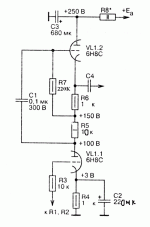Today, I found some used parts and decided to build something off them.
I ended up building a mu-follower preamp using the attached 6H8C mu-follower schema (from Ian).
Here are the differences from the schema:
1. B+ is 400V
2. Tubes are 6FQ7 (9-pin equivalence of 6SN7).
3. C1 is 0.047uF
4. R7 is 1M
5. R3 is 1M
There was no apparent issue, and it sounds good. I then did some measurements:
1. There is 176V across each tube
2. Voltage across R6 (10K) is a little lower than 48V => approx. 4.8mA
3. Voltage across the 1K cathode resistors are a little lower than 4.8V => a little above -4.8.
I then looked at the tube data and wondered why the above numbers ...
According to the plate current vs plate voltage curve, if the plate current is at 4.8mA and the plate is at 176V, it should be at -6.0V. However, I am seeing -4.8. Does it mean the tubes are weak? Both tubes were reported as good (not marginally) by the tube tester. I wonder why the tube data and the actually measurement have this much difference.
Does anyone want to shed some lights?
PS, I matched both tubes, so they both measured very close to the above numbers.
Thanks!!
I ended up building a mu-follower preamp using the attached 6H8C mu-follower schema (from Ian).
Here are the differences from the schema:
1. B+ is 400V
2. Tubes are 6FQ7 (9-pin equivalence of 6SN7).
3. C1 is 0.047uF
4. R7 is 1M
5. R3 is 1M
There was no apparent issue, and it sounds good. I then did some measurements:
1. There is 176V across each tube
2. Voltage across R6 (10K) is a little lower than 48V => approx. 4.8mA
3. Voltage across the 1K cathode resistors are a little lower than 4.8V => a little above -4.8.
I then looked at the tube data and wondered why the above numbers ...
According to the plate current vs plate voltage curve, if the plate current is at 4.8mA and the plate is at 176V, it should be at -6.0V. However, I am seeing -4.8. Does it mean the tubes are weak? Both tubes were reported as good (not marginally) by the tube tester. I wonder why the tube data and the actually measurement have this much difference.
Does anyone want to shed some lights?
PS, I matched both tubes, so they both measured very close to the above numbers.
Thanks!!
Attachments
Don't think the Fluke DMM loads the circuit this much. The measurement across the 4 x 1K resistors and 2 x10K resistors were quite consistent to calculate to be 4.8mA of plate current. The 20% off is not likely caused by the DMM's loading. Looks like it is just tube deviation.3 volts on 1k means 30 volt on 10k. You find 150-100=50 volts !So the 10k isn't 10k or your voltmeter is loading the circuit to much.
Mona
According to this paper, -4.8 is still pretty good operating point for the 6CG7 (same as 6FQ7 with a shield), it does sound very good.
Thanks,
- Status
- This old topic is closed. If you want to reopen this topic, contact a moderator using the "Report Post" button.
